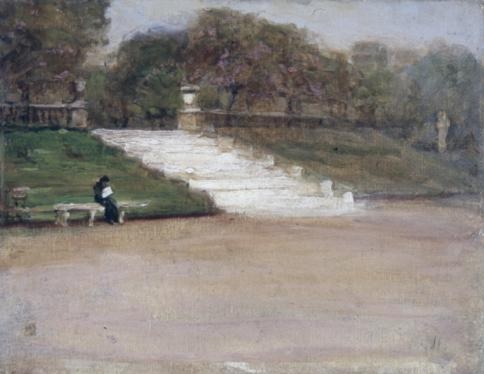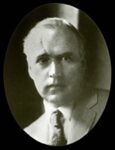
Clarence Hinkle
American, 1880-1960
Luxembourg Gardens, 1906-1907 ca.
oil on canvas
10 5/8 × 13 3/4 in.
SBMA, Gift of Mabel Bain Hinkle
1961.15

Updated photo of Clarence Hinkle, Lagune Plein Air Painters Association
“Hinkle was one of only a few native Californians of his generation that became a nationally known artist.” - Laguna Art Museum
RESEARCH PAPER
Clarence Hinkle painted landscapes, still-lives and portraits throughout his career. One example of his landscapes is Luxembourg Gardens, which was painted between 1906 and 1907. It is oil on canvas. Luxembourg Gardens is one of Hinkle’s earlier pieces of artwork.
The Gardens are infused with light as well as having a shadowy quality, a nod to the impressionists. The background of the trees is loosely defined by patches of greens and browns somewhat muted. One’s eye is drawn to the horizontal lines especially at the center of the painting. The impasto, thick heavy brush strokes of paint give texture to the white steps.
There is a subordination quality to the painting. On the left-hand side, the green brush strokes are more defined, whereas on the right-hand side of the painting, the green strokes are more blended, perhaps a way of offering variety or perspective. In the foreground there is a figure wearing black, possibly reading something.
History has it that the Luxembourg Gardens were created at the request of Queen Marie de Medici in 1612. The Gardens, which cover over 61 acres of land, are split into French and English gardens, often offering statues to view or activities for children (en-parisinfo.com). It seems that in this painting, Hinkle captured a quiet part of the Gardens on a quiet early morning or late afternoon. The only person in this area of the garden is the figure on the bench.
Hinkle’s Luxembourg Gardens is closely aligned with some of the paintings he did in Holland around the same time. During that time much of his work was said to be small landscapes painted in the same color palette of muted greens, browns and grays, which was said to be more typical of The Hague School. It was when he went to France that his work became more impressionistic, hence Luxembourg Gardens.
Clarence Hinkle was born in Auburn, California on June 19, 1880. His childhood was reported as filled with several outdoor activities, one culminating in being kicked by a horse, leaving a deep scar on the left side of his forehead.
Hinkle began studying art at eighteen. First in California where he studied with William Franklin Jackson who was both a portrait artist and a landscape artist that painted in the impressionistic era. When Hinkle moved east in 1901, he studied at the Art Students League of New York. One of his teachers that had a major influence on him was John Twatchman who was a famous American Impressionist at the time (Janet Blake). In 1906, he was awarded a two-thousand dollar traveling scholarship from the Pennsylvania Academy to continue his studies in Europe. Hinkle would first stay in Holland, then make his way to Paris, where he studied at the Academy Julian. One might conjecture this is when he painted Luxembourg Gardens.
Hinkle stayed in Europe for six years before deciding that he wanted to return to California. Hinkle was reported as saying to a journalist, “California has so much more color and sunlight” (Janet Blake). Upon returning to California, he would eventually move from San Francisco to Los Angeles. It was during the time he was teaching at Los Angeles School of Design that he met his wife Mabel. Mabel became the subject of many of his portraits.
The Hinkles spent time in Laguna Beach before moving to Santa Barbara in 1935. In Montecito they built a home with a panoramic view of Santa Barbara and the Harbor and surrounded by rugged landscape trees and flowers. His artwork then began to capture where he lived. He began to paint in a style that was more realistic interpretations of landscapes with bravura. Hinkle throughout his life would be influenced by different artists such as Goya and Matisse, often changing his approach to his paintings (Traditional Fine Arts Association). In the 1920s especially, his paintings became bold and more expressionistic. Hinkle continued to exhibit up until his death in 1960. It is alleged that he met with James W. Foster, the director of the Santa Barbara Museum, to discuss an upcoming exhibit of his paintings. Although he passed away before the exhibition, the Santa Barbara Museum of Art exhibited 37 pieces from Clarence Hinkle’s paintings spanning from 1900 to 1960, two months after his death. (Janet Blake)
Prepared for the Santa Barbara Museum of Art Docent Council by Dana Staub, February, 2023
BIBLIOGRAPHY
Blake, Janet and Anderson, Sarah. Laguna Art Museum, 2012. Print
https://en pariinfo.com, Office of tourisme Paris. Retrieved 9 January 2023
https://LagunaArtMuseum.org Retrieved 8 January 2023
https//en.wikipedia.org/wiki/Clarence_Hinkle. Retrieved 8 January 2023
https:// tfail.org In Love With Painting, “ The Life and Art of Clarence Hinkle” by Janet Blake
https://lpapa.org, Laguna Plein Air Painters Association., Jean Stern Retrieved 9 January 2023
www.youtube.com/watch Untitled Seascape c1925- Laguna Art Museum 6/6/2012. Retrieved 10 January 2023
SBMA CURATORIAL LABELS
The talented Hinkle is California’s most successful exponent of international modernism of the last century. Study abroad throughout Europe, afforded by a traveling scholarship from the Pennsylvania Academy of the Fine Arts, lent him a painterly sophistication, as seen here in this atmospheric depiction of the famed grounds of the Luxembourg Gardens in Paris. This softer Impressionist idiom would eventually give way to a more energetic and linear style, which he applied to our local Santa Barbara landscape after moving to Montecito with his wife Mabel in 1935.
- Ridley-Tree Reinstallation, 2022
